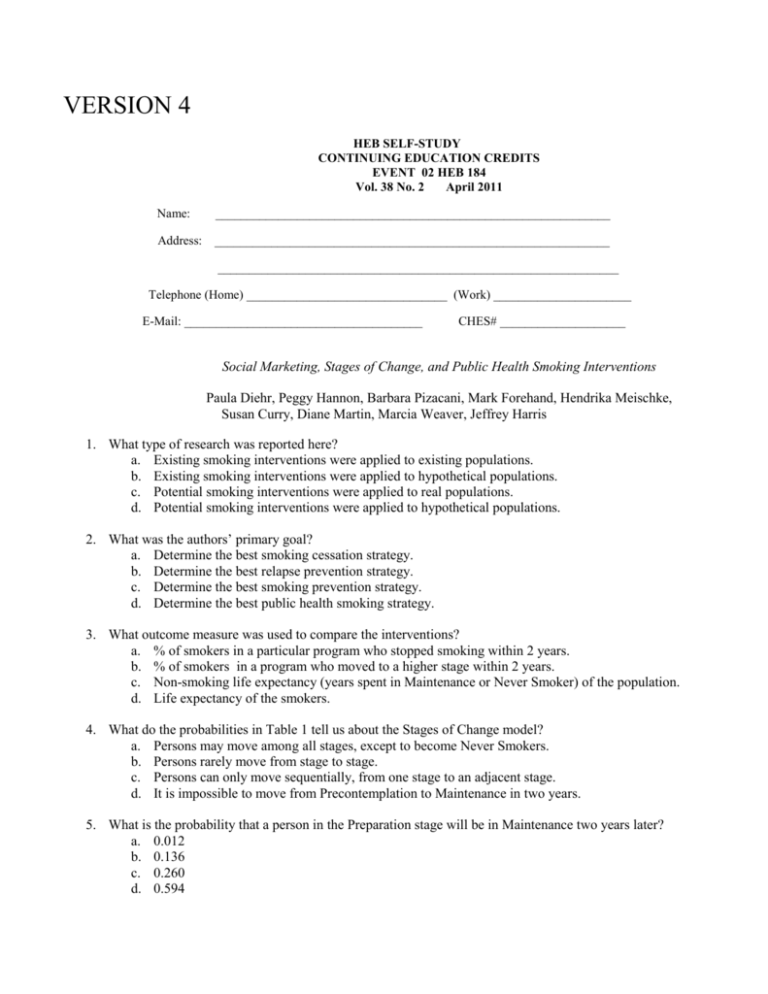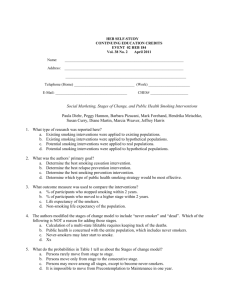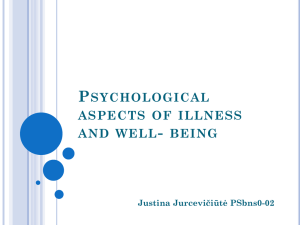stages_test
advertisement

VERSION 4 HEB SELF-STUDY CONTINUING EDUCATION CREDITS EVENT 02 HEB 184 Vol. 38 No. 2 April 2011 Name: _______________________________________________________________ Address: _______________________________________________________________ ________________________________________________________________ Telephone (Home) ________________________________ (Work) ______________________ E-Mail: ______________________________________ CHES# ____________________ Social Marketing, Stages of Change, and Public Health Smoking Interventions Paula Diehr, Peggy Hannon, Barbara Pizacani, Mark Forehand, Hendrika Meischke, Susan Curry, Diane Martin, Marcia Weaver, Jeffrey Harris 1. What type of research was reported here? a. Existing smoking interventions were applied to existing populations. b. Existing smoking interventions were applied to hypothetical populations. c. Potential smoking interventions were applied to real populations. d. Potential smoking interventions were applied to hypothetical populations. 2. What was the authors’ primary goal? a. Determine the best smoking cessation strategy. b. Determine the best relapse prevention strategy. c. Determine the best smoking prevention strategy. d. Determine the best public health smoking strategy. 3. What outcome measure was used to compare the interventions? a. % of smokers in a particular program who stopped smoking within 2 years. b. % of smokers in a program who moved to a higher stage within 2 years. c. Non-smoking life expectancy (years spent in Maintenance or Never Smoker) of the population. d. Life expectancy of the smokers. 4. What do the probabilities in Table 1 tell us about the Stages of Change model? a. Persons may move among all stages, except to become Never Smokers. b. Persons rarely move from stage to stage. c. Persons can only move sequentially, from one stage to an adjacent stage. d. It is impossible to move from Precontemplation to Maintenance in two years. 5. What is the probability that a person in the Preparation stage will be in Maintenance two years later? a. 0.012 b. 0.136 c. 0.260 d. 0.594 Catalani & Minkler (2009). Photovoice: A Review of the Literature in Health and Public Health. 6. What types of smoking interventions were evaluated in this paper? Interventions that: a. Move current smokers (precontemplation, contemplation, preparation) to a higher stage of change. b. Increase one of the transition probabilities numbered 1 through 9 by 10%. c. Decrease one of the transition probabilities numbered 1 through 9 by 10%. d. Increase one of the transition probabilities numbered 1, 3, 5, or 7 or decrease one of the transition probabilities 2, 4, 6, 8, or 9. 7. For a population where all persons were initially in the “Preparation” stage, which type of potential public health intervention was found to be the most effective? a. 4 (fewer from Preparation to Contemplation) b. 5 (more from Preparation to Action) c. 7 (more from Action to Maintenance) d. 9 (fewer from Never Smoker to Maintenance) 8. Social marketing theory recommends that the population of interest be segmented into homogeneous groups, with different interventions for each group. In this paper, how were those groups defined? a. By city. b. By ethnicity. c. By stage of change. d. By age and sex. 9. The authors acknowledge some limitations of their data. How did they address those limitations? a. Conducted a meta-analysis of published smoking cessation interventions. b. Conducted a sensitivity analysis comparing results from different datasets and repeating analyses using different assumptions. c. Used census data for comparison of the paper’s results with national information. d. Conducted a new two-wave survey of smoking stages of change to collect more appropriate measures. 10. Suppose you are the director of H.R. at a large workplace where all employees are smokers or former smokers, and you want to increase the non-smoking life expectancy of the employees. What type of intervention does this paper suggest would be most effective? a. Sponsor a relapse-prevention program for former smokers. b. Create a separate employee smoking lounge. c. Charge higher coinsurance and deductibles for smokers’ health insurance. d. Sponsor smoking quitlines for employees who smoke. Social Marketing, Stages of Change, and Public Health Smoking Interventions Paula Diehr, Peggy Hannon, Barbara Pizacani, Mark Forehand, Hendrika Meischke, Susan Curry, Diane Martin, Marcia Weaver, Jeffrey Harris ANSWERS 1 2 3 4 5 6 7 8 9 10 d d c a b d c c b a






